Different organisms play diverse roles in ecological systems
Transformations of matter and energy in ecological systems are performed by both large and small forms of life. These different organisms can play unique roles within ecological systems. In this section, we will examine how organisms interact with each other and the environment. We will see how ecologists categorize species based on how they obtain their energy and how they interact with other species, describe the major groups of organisms that have evolved and the diverse ecological roles found within each group, and examine the concepts of habitat and niche.
Broad Evolutionary Patterns
Early in the history of Earth, ecosystems were dominated by bacteria. The ancient evolution of these groups is still debated by scientists, but a leading hypothesis, illustrated in Figure 1.6, is that the bacteria are the oldest group of organisms. Over time, the bacteria gave rise to the archaea. Bacteria and archaea are both prokaryotic organisms, which are single-cell organisms that do not contain distinct cell organelles, such as a nucleus. These evolutionary events likely happened in the ocean and may have occurred near the deep-sea vents that we discussed in the chapter opener. If so, it may also be the case that the first bacteria used chemosynthesis and this later gave rise to the evolution of photosynthesis.
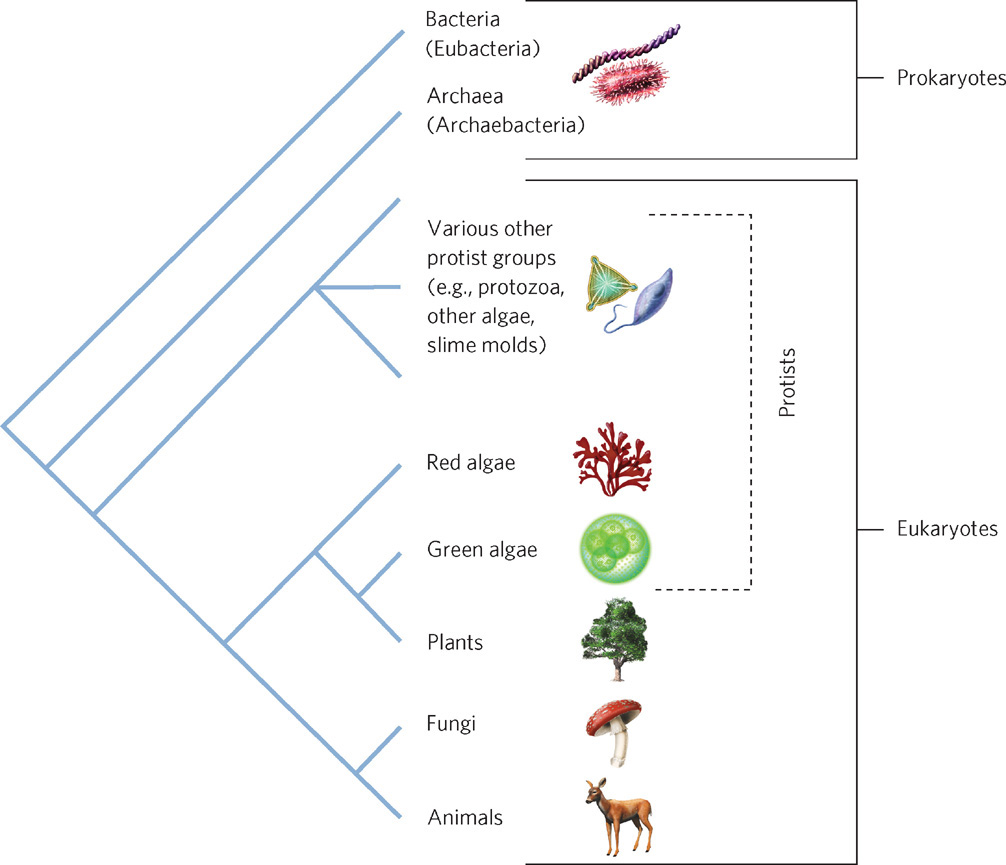
Over time, eukaryotic organisms, which have distinct cellular organelles, evolved. The key event in the evolution of eukaryotes occurred when one bacterium engulfed another. The engulfed bacterium became what we now know as the mitochondrion, an important organelle for cellular respiration in eukaryotic organisms. This ancestor subsequently gave rise to all modern organisms that contain mitochondria including red algae, green algae, plants, fungi, and animals. As the evolution of the eukaryotes progressed, there was a second key event. A eukaryotic cell engulfed a bacterium that was capable of photosynthesis and the engulfed bacterium evolved into what we now know as the chloroplast. The group of eukaryotic organisms that contained chloroplasts subsequently gave rise to modern-day red algae, green algae, and plants. Those species that didn’t contain chloroplasts gave rise to modern-day fungi and animals.
11
Bacteria also modified the biosphere, making it possible for other forms of life to exist. For example, photosynthetic bacteria that were present more than 3 billion years ago produced oxygen as a byproduct of photosynthesis. The higher concentrations of oxygen in the atmosphere and oceans favored the evolution of additional life forms that required oxygen, such as plants and animals. Despite all these changes, bacteria have persisted to the present day. As we shall see, their unique biochemical capabilities allow them to consume resources that their more complex descendants cannot use, and to tolerate ecological conditions that are beyond the capacities of other organisms.
Ecosystems depend on the activities of many forms of life. Each major group fills a unique and necessary role in the biosphere. We will now briefly review the major groups of organisms including bacteria, protists, plants, fungi, and animals.
Bacteria
Algal bloom A rapid increase in the growth of algae in aquatic habitats, typically due to an influx of nutrients.
Although bacteria are tiny, their enormous range of metabolic capabilities enables them to accomplish many unique biochemical transformations and to occupy parts of the biosphere where plants, animals, fungi, and most protists cannot survive. Some bacteria can assimilate molecular nitrogen (N2) from the atmosphere, which they use to synthesize proteins and nucleic acids. Other species of bacteria, such as those living in deep-sea hydrothermal vents, can use inorganic compounds such as hydrogen sulfide (H2S) as sources of energy in chemosynthesis. Furthermore, many bacteria can live under anaerobic conditions—in which free oxygen is lacking—such as in mucky soils and sediments, where their metabolic activities release nutrients that can be taken up by plants. Finally, some bacteria, including cyanobacteria (colloquially known as blue-green algae), can conduct photosynthesis. Cyanobacteria account for a large fraction of the photosynthesis that occurs in aquatic ecosystems. When bodies of water contain high amounts of nutrients, cyanobacteria can form dense populations that turn the water green, an event known as an algal bloom (Figure 1.7). Later in the book we will have much more to say about the special place of bacteria in ecosystems.
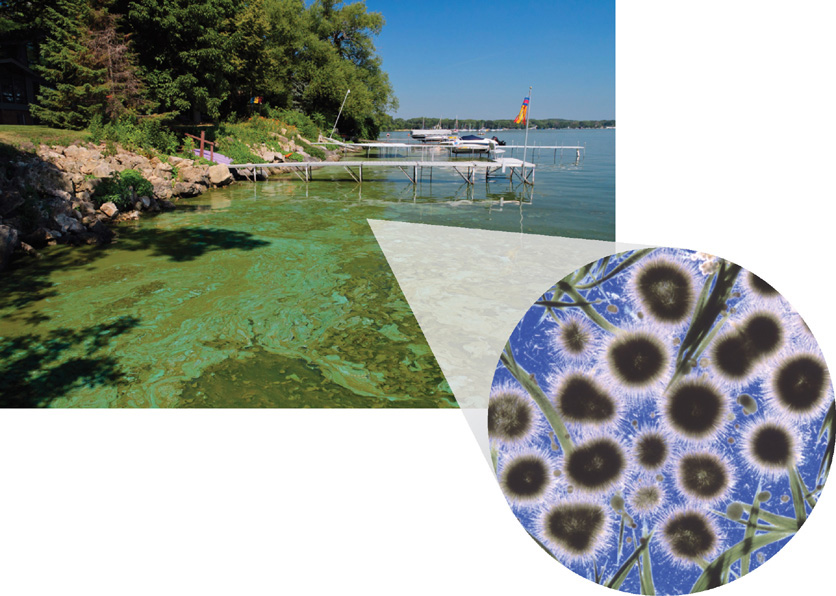
12
Protists
Protists are a highly diverse group of mostly single-celled eukaryotic organisms that includes the algae, slime molds, and protozoans. This bewildering variety of protists fills almost every ecological role. For instance, algae are the primary photosynthetic organisms in most aquatic ecosystems. Some algae can form large plant-like structures, such as the seaweed known as kelps, which can grow up to 100 m in length. Because of this large size, regions of the ocean containing large amounts of kelps, such as that shown in Figure 1.8, are called kelp forests. Although kelps may resemble large plants, the actual organization of kelp tissues is less structurally complex than that of trees and other plants.
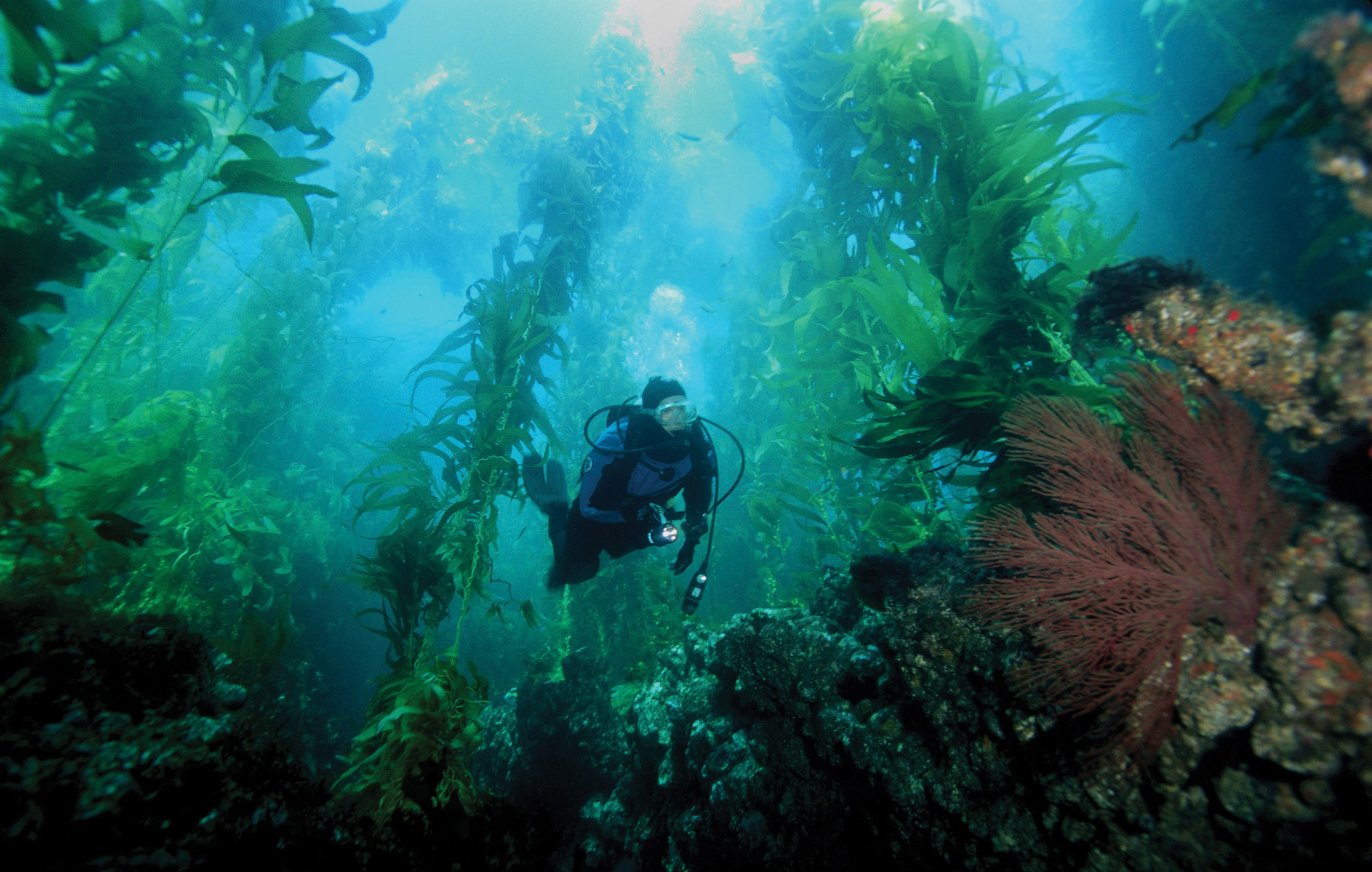
Other protists are not photosynthetic. Foraminifera and radiolarians are protists that feed on tiny particles of organic matter or absorb small dissolved organic molecules. Some of the ciliate protozoans are effective predators of other microorganisms. Many protists live in the guts or other tissues of a host organism where they might be helpful or cause harm. For example, termites are a type of insect that consumes large amounts of cellulose. Cellulose is a very difficult substance for animals to digest, but the termite has a community of protists—as well as bacteria—in its gut that are very effective at breaking down the cellulose. Some of the best known harmful protists include Plasmodium, which causes malaria in humans, and Trypanosoma brucei, a protist that produces sleeping sickness.
Plants
Plants are well known for their role in using the energy of sunlight to synthesize organic molecules from CO2 and water. On land, most plants have structures with large exposed surfaces—their leaves—to capture the energy of sunlight (Figure 1.9a). Leaves are thin because surface area is more important than leaf thickness for capturing light energy. To obtain carbon, terrestrial plants take up gaseous CO2 from the atmosphere. At the same time, they lose large amounts of water by evaporation from their leaf tissues to the atmosphere. Thus, plants need a steady supply of water to replace the water lost during photosynthesis. Most plants are firmly rooted in the ground and in constant contact with water in the soil. Others, including orchids and a variety of tropical “air plants” (known as epiphytes), typically grow by attaching themselves to other plants—often the trunks of trees—and can photosynthesize only in humid environments that are bathed in clouds (Figure 1.9b).
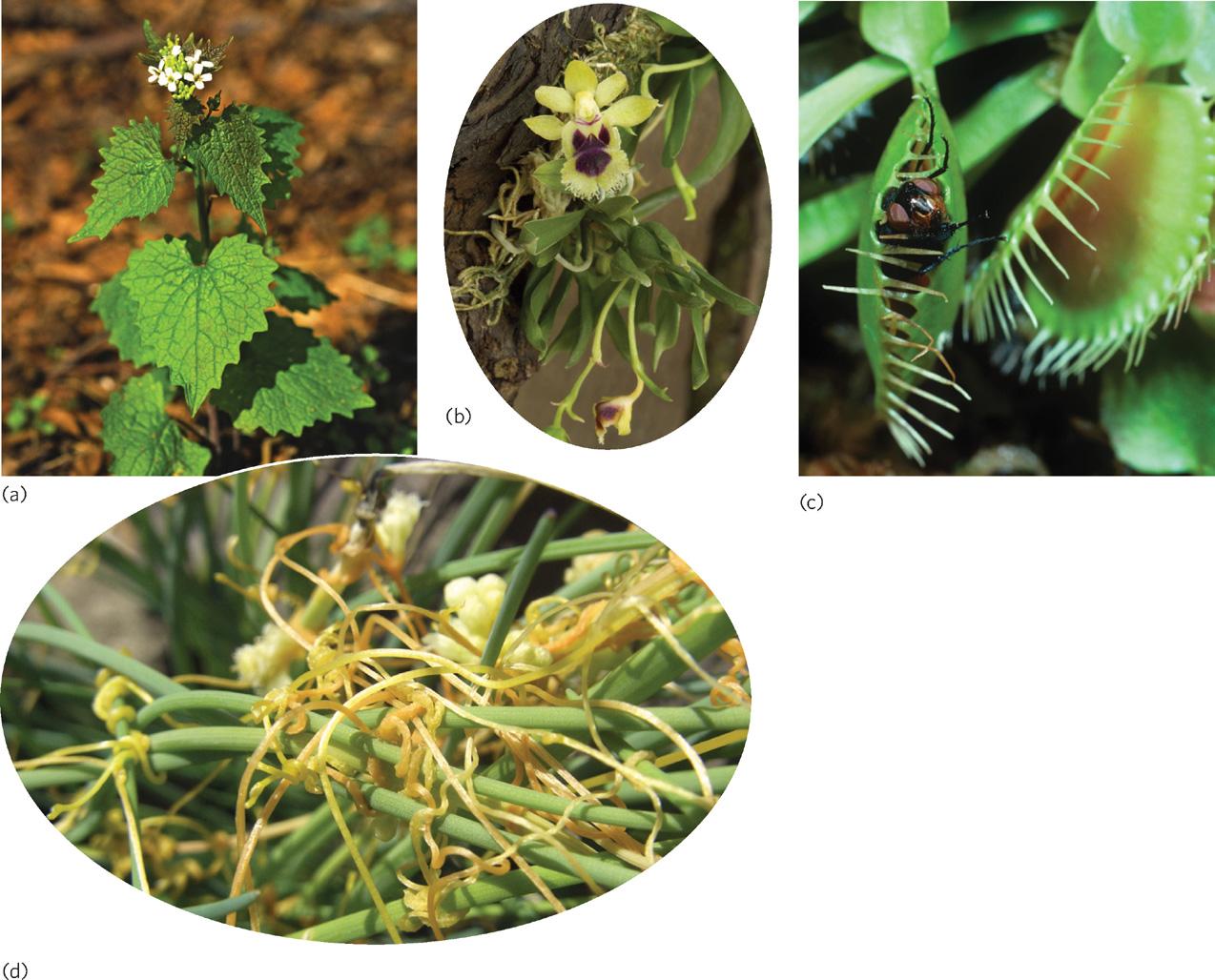
13
Although we typically envision plants as organisms that obtain their energy from sunlight, plants can also obtain energy in other ways. For example, several groups of plants have evolved to be simultaneously photosynthetic and carnivorous. These plants include the Venus fly trap (Dionaea muscipula), several species of sundews, and several species of pitcher plants (Figure 1.9c). They often live in locations that are low in nutrients, so the invertebrates they trap and consume provide an additional source of nutrients and energy. In addition, more than 400 species of plants—including more than 200 species of orchids—lack chlorophyll and therefore cannot photosynthesize to obtain energy. Scientists once thought that these plants were acting as decomposers and obtained their organic carbon from dead organic matter, but we now know that many of these plants are in fact acting as parasites on fungi, which are the real decomposers in the ecosystem. These parasitic plants obtain the vast majority of their organic carbon from the fungi. Other plants, such as dodder, have little chlorophyll and no roots (Figure 1.9d). Instead, the stringy plant—also known as strangle weed or devil’s guts—winds around other plants, penetrates their tissues, and sucks up water, nutrients, and products of photosynthesis. The dodder is a serious pest for many farm crops.
Fungi
Fungi assume unique roles in the biosphere because of their distinctive growth form. With the exception of unicellular yeasts and their relatives, fungi—like plants and animals—are multicellular. Most fungal organisms consist of threadlike structures called hyphae that are only a single cell in diameter. These hyphae may either form a loose network, which can invade plant or animal tissues or dead leaves and wood on the soil surface, or grow together into reproductive structures such as mushrooms (Figure 1.10). Because fungal hyphae are able to penetrate deeply into tissue, they readily decompose dead plant material, eventually making nutrients available to other organisms. Fungi digest their foods externally and secrete acids and enzymes into their immediate surroundings. Such digestion allows fungi to decompose dead organisms and dissolve nutrients from soil minerals.
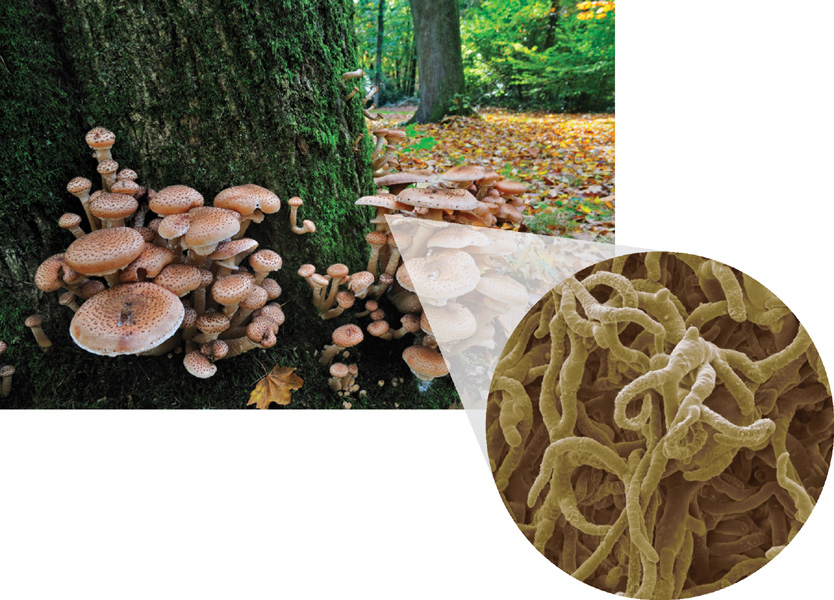
14
Although most fungi function as decomposers, they can interact with other species in both positive and negative roles. Many fungi live in mutualistic relationships with plants, living either around or within the roots of plants. Using their extensive network of hyphae, they obtain scarce nutrients from the surrounding soil and provide them to the plant. In exchange, the plant provides the products of photosynthesis. Other fungi, though, can act as pathogens. Several closely related species of fungus cause Dutch elm disease, which has caused widespread death in several species of elm trees throughout North America and Europe during the past 100 years. Fungal pathogens are also a major problem for many crops including potatoes, wheat, and rice.
Animals
Animals play a wide range of roles as consumers in ecological systems. Some animals, for example, elephants, gazelles, and voles, eat plants. Other animals, such as mountain lions, rattlesnakes, and frogs, eat other animals. Ticks, lice, and tapeworms are animals that live on or in other organisms. Finally, animals such as flies, bees, butterflies, moths, and bats can serve as important plant pollinators and seed dispersers.
15
Categorizing Species Based on Sources of Energy
Ecologists often categorize organisms according to how they obtain energy, as illustrated in Figure 1.11. Organisms that use photosynthesis to convert solar energy into organic compounds or use chemosynthesis to convert chemical energy into organic compounds are known as producers or autotrophs. Organisms that obtain their energy from other organisms are known as consumers or heterotrophs. There are many different kinds of heterotrophs. Some consume plants, some consume animals, and some consume dead organic matter. In the next section, we will discuss these various interactions in more detail.
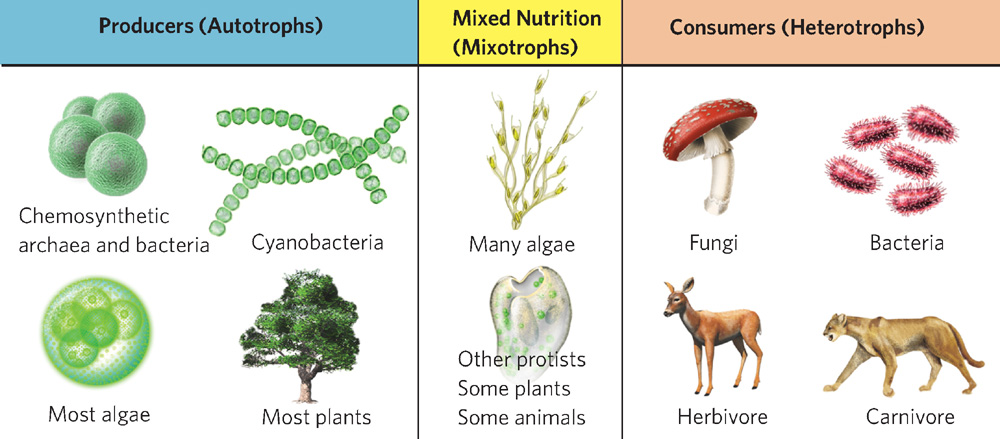
Producer An organism that uses photosynthesis to convert solar energy into organic compounds or uses chemosynthesis to convert chemical energy into organic compounds. Also known as Autotroph.
Consumer An organism that obtains its energy from other organisms. Also known as Heterotroph.
Mixotroph An organism that obtains its energy from more than one source.
Not all species fit neatly into categories of autotrophs or heterotrophs. Some species can obtain their sources of carbon through a variety of ways. Because these species take a mixed approach to obtaining their energy, they are called mixotrophs. Mixotrophs are quite common in nature. For example, some bacteria can switch back and forth between photosynthesis and chemosynthesis. In addition, many species of algae can photosynthesize and obtain organic carbon by engulfing bacteria, protists, and bits of organic carbon that exist in the water. Other mixotrophs include the carnivorous plants that we discussed earlier in this chapter. These plants obtain their energy both from photosynthesis and from consuming invertebrates.
Types of Species Interactions
In considering the diversity of species that exist on Earth, we are often interested in the roles that they play. Ecologists categorize species by the types of interactions they have with other species, as you can see from the examples in Figure 1.12. Below is a brief introduction to these interactions, beginning with the various types of consumers, each of which will be covered in much greater detail in later chapters.
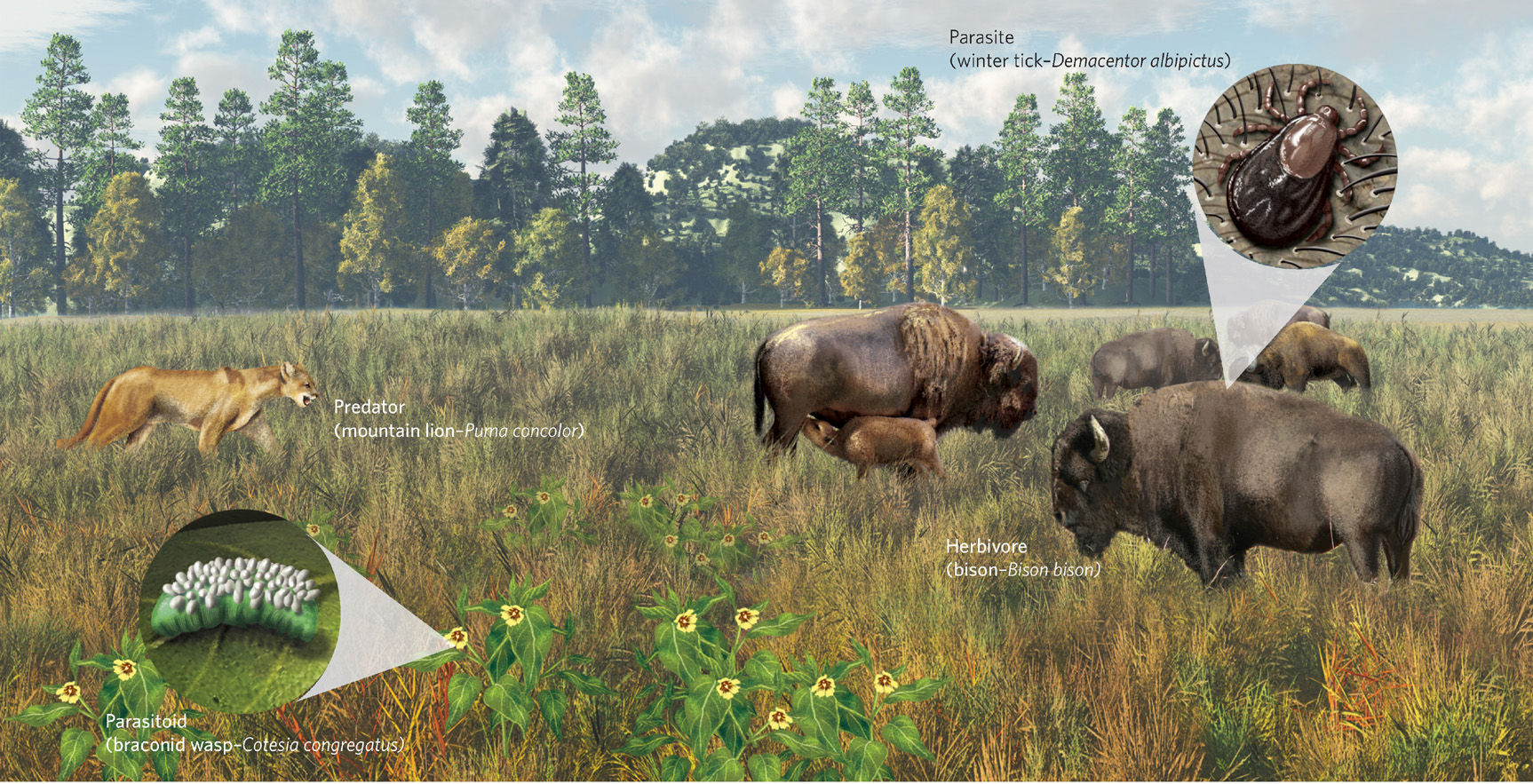
16
Predation
Predator An organism that kills and partially or entirely consumes another individual.
Predators are organisms that kill and partially or entirely consume another individual. The mountain lion, for example, is a predator that kills white-tailed deer (Odocoileus virginianus) and many other species of prey.
Parasitoid An organism that lives within and consumes the tissues of a living host, eventually killing the host.
Parasitoids represent a special kind of predator. Parasitoids lay their eggs on or inside other animals, particularly insects, and the eggs hatch into larvae that consume the host individual from the inside, eventually killing it. Most parasitoid species are wasps and flies.
Parasitism
Parasite An organism that lives in or on another organism, but rarely kills it.
Parasites are organisms that live in or on another organism, called the host. An individual parasite rarely kills its host, although some hosts die when they are infected by a large number of parasites. Common parasites include tapeworms and ticks. When a parasite causes a disease, it is called a pathogen. Pathogens include several species of bacteria, viruses, protists, fungi, and a group of worms called helminths.
Pathogen A parasite that causes disease in its host.
Herbivory
Herbivore An organism that consumes producers such as plants and algae.
Herbivores are organisms that consume producers, such as plants and algae. When an herbivore consumes a plant, it typically consumes only a small portion of the plant, and does not kill the plant. For example, caterpillars consume a few leaves or parts of leaves, which the plant can regenerate. Cattle consume the tops of grass leaves, but do not destroy the growing region, located at the base of the plant.
Competition
Competition An interaction with negative effects between two species that depend on the same limiting resource to survive, grow, and reproduce.
Competition can be defined as an interaction with negative effects between two species that depend on the same limiting resource to survive, grow, and reproduce. For example, two species of grass might compete for nitrogen in the soil. As a result, the survival, growth, and reproduction of each is reduced when living with the other species of grass in the same area compared to when they are living in the area alone. Similarly, coyotes and wolves might compete for the same prey animals in the forest, such that they survive, grow, and reproduce better when they are living alone than when the other species is present. Competition for limited resources is a very common interaction in nature.
Mutualism
When two species interact in a way such that each species receives benefits from the other, their interaction is a mutualism. The lichens in Figure 1.13, for example, are composed of a fungus living together with green algal cells or cyanobacteria as a single organism. The fungus provides nutrients to the algae and the algae provide carbohydrates from photosynthesis to the fungus. Other examples of mutualisms include the bacteria that help digest plant material in the guts of cattle, fungi that help plants extract mineral nutrients from the soil in return for carbohydrate energy from the plant, and honeybees that pollinate flowers as they obtain nectar.
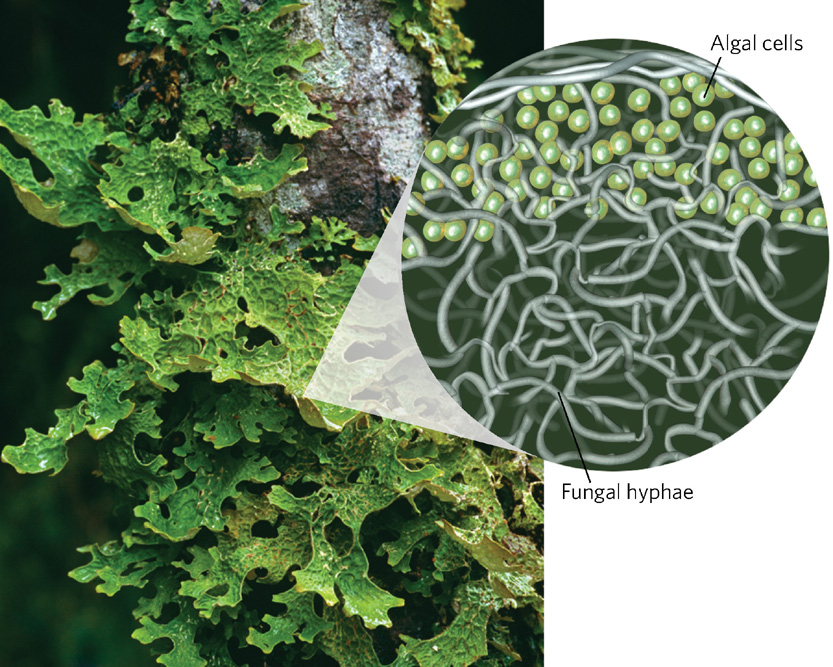
Mutualism An interaction between two species in which each species receives benefits from the other.
17
Commensalism
Commensalism An interaction in which two species live in close association and one species receives a benefit while the other experiences neither a benefit nor a cost.
Commensalisms are interactions in which two species live in close association and one species receives a benefit while the other experiences neither a benefit nor a cost. For example, plants such as burdock (Arctium lappa) produce fruits containing tiny barbs that stick to the hair of mammals that brush up against it. The burdock receives a benefit of having its seeds dispersed while the mammal is neither helped nor harmed by carrying these fruits on its body.
Symbiotic relationship When two different types of organisms live in a close physical relationship.
Because organisms are specialized for particular ways of life, many different types of organisms are able to live together in close association. A close physical relationship between two different types of organisms is referred to as a symbiotic relationship. Many parasites, parasitoids, mutualists, and commensal organisms live in symbiotic relationships.
When considering the different types of interactions among species, it can be helpful to categorize interactions between the two participants as positive (+), negative (–), or neutral (0). Table 1.1 provides a summary of species interactions using this approach.
THE OUTCOME OF INTERACTIONS BETWEEN TWO SPECIES
| TYPE OF INTERACTION | SPECIES 1 | SPECIES 2 |
|---|---|---|
| PREDATION/PARASITOIDISM | + | − |
| PARASITISM | + | − |
| HERBIVORY | + | − |
| COMPETITION | − | − |
| MUTUALISM | + | + |
| COMMENSALISM | + | 0 |
| Interactions that provide a benefit to a species are indicated by a "+" symbol, interactions that cause harm to a species are indicated by a "−" symbol, and interactions that have no effect on a species are indicated by a "0" symbol. | ||
Consumers of Dead Organic Matter
Scavenger An organism that consumes dead animals.
Consumers of dead organic matter—including scavengers, detritivores, and decomposers—also play important roles in nature. Scavengers, such as vultures, consume dead animals. Detritivores, such as dung beetles and many species of millipedes, break down dead organic matter and waste products—known as detritus—into smaller particles. Decomposers, such as many species of mushrooms, break down dead organic material into simpler elements and compounds that can be recycled through the ecosystem.
Detritivore An organism that feeds on dead organic matter and waste products that are collectively known as detritus.
Decomposer Organisms that break down dead organic material into simpler elements and compounds that can be recycled through the ecosystem.
Habitat Versus Niche
If you were to walk through a meadow in the eastern or central United States, you would likely come across the eastern cottontail rabbit (Sylvilagus floridanus). This species thrives in abandoned farm fields that are full of grasses and other tall wildflowers interspersed with shrubs. These plants provide food for the rabbit and protection from its many predators, including coyotes (Canis latrans) and several species of hawk. In considering species in nature, ecologists find it useful to distinguish between where an organism lives and what it does.
Habitat The place, or physical setting, in which an organism lives.
The habitat of an organism is the place, or physical setting, in which it lives. In the case of the rabbit, the habitat consists of old fields that contain grasses, wildflowers, and shrubs. Habitats are distinguished by physical features, often including the predominant form of plant or animal life. Thus, we speak of forest habitats, desert habitats, stream habitats, and lake habitats (Figure 1.14).

During the early years of ecological research, scientists developed a complex system of classifying habitats. For example, they began by distinguishing between terrestrial and aquatic habitats. Among aquatic habitats, they identified freshwater and marine habitats. Among the marine habitats, they found coastal habitats, the open ocean, and the ocean floor. As such classifications became more finely divided, the distinctions began to break down since scientists found that habitat types overlap and that absolute distinctions rarely exist. However, the idea of habitat is nonetheless useful because it emphasizes the variety of conditions to which organisms are exposed. For example, inhabitants of extreme ocean depths and tropical rain forest canopies experience altogether different conditions of light, pressure, temperature, oxygen concentration, moisture, and salt concentrations, as well as differences in food resources and predators.
18
19
Niche The range of abiotic and biotic conditions that an organism can tolerate.
An organism’s niche includes the range of abiotic and biotic conditions it can tolerate. In the case of the cottontail rabbit, its niche includes the ranges of temperature and humidity that it can tolerate, the plants that it eats, and the predatory hawks and coyotes with which it coexists. An important ecological principle states that each species has a distinct niche. No two species have exactly the same niche because each has distinctive attributes of form and function that determine the conditions it can tolerate, how it feeds, and how it escapes enemies. Consider the hundreds of insect species that might live in a garden; each has a unique niche in terms of the food that it eats (Figure 1.15). For example, the caterpillar of the cabbage white butterfly (Pieris rapae) feeds on the group of plants that have been cultivated from the wild mustard plant (Brassica oleracea) including cabbage, broccoli, and cauliflower. However, the Colorado potato beetle (Leptinotarsa decemlineata) feeds almost exclusively on the leaves of potato plants (Solanum tuberosum). Similarly the European corn borer (Ostrinia nubilalis) feeds primarily on corn plants (Zea mays). The variety of habitats and niches holds the key to much of the diversity of living organisms.
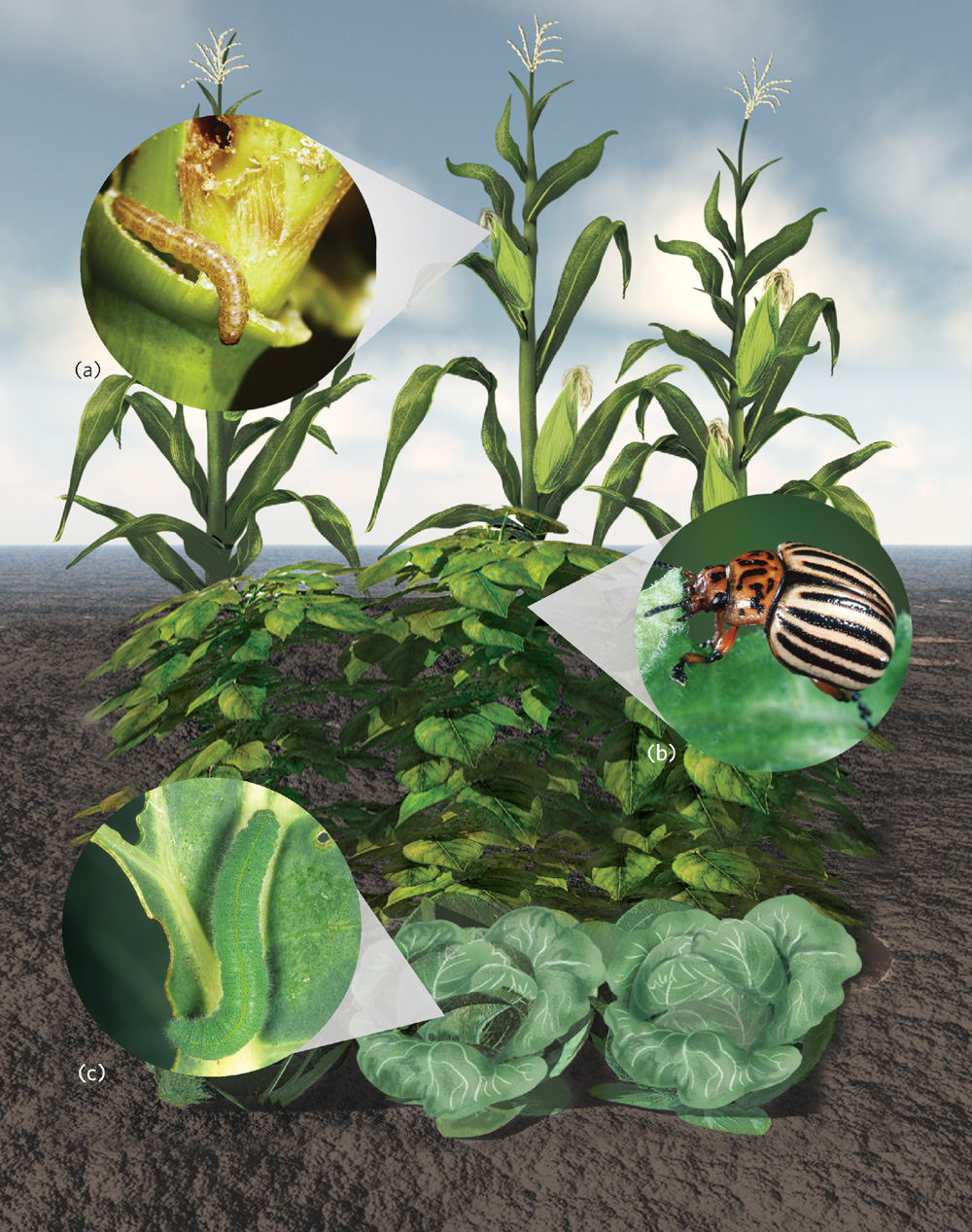
20